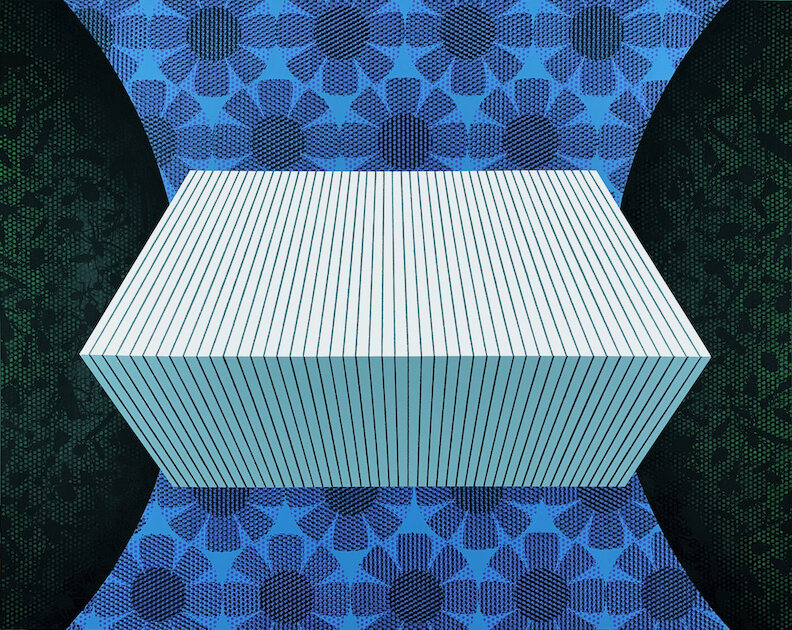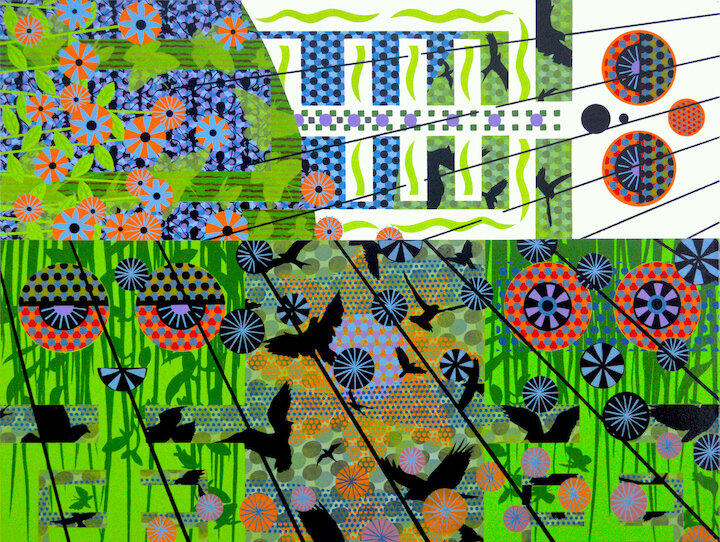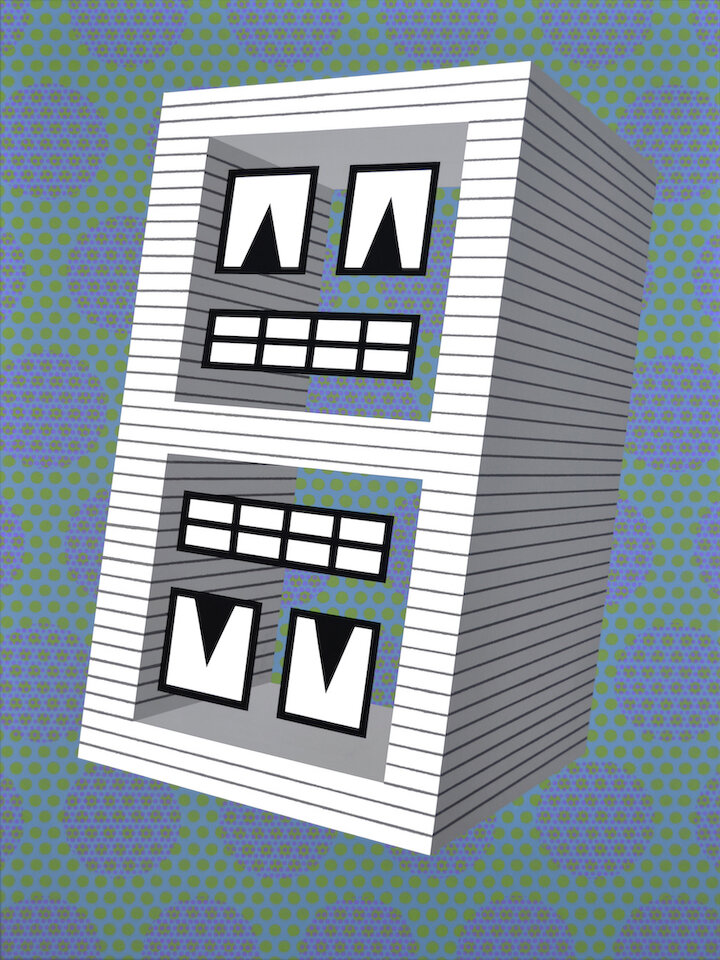Interview with artist Charles Henry James
Charles Henry James is a Little Rock artist originally from upstate New York. His paintings are of an imaginary world where chaos meets social consciousness. He has exhibited in New York, Paris, and Amsterdam, and has had several solo shows in Arkansas. His work has been in the Delta Exhibition seven times. More of his work can be found at his website charleshenryjames.com.
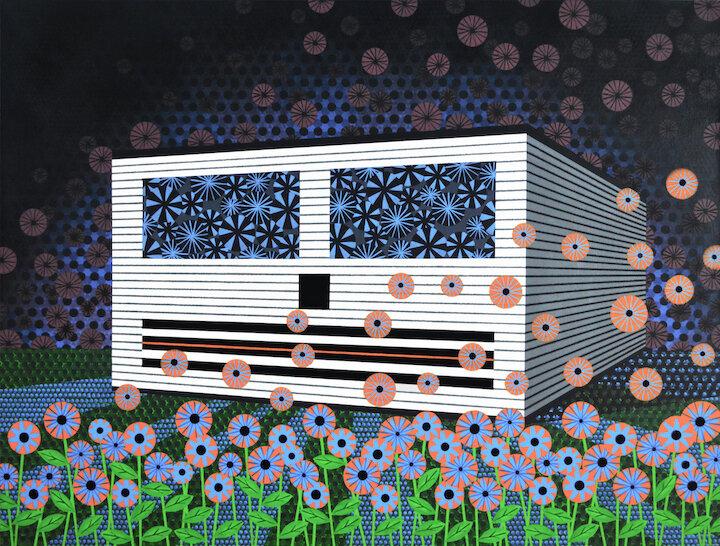
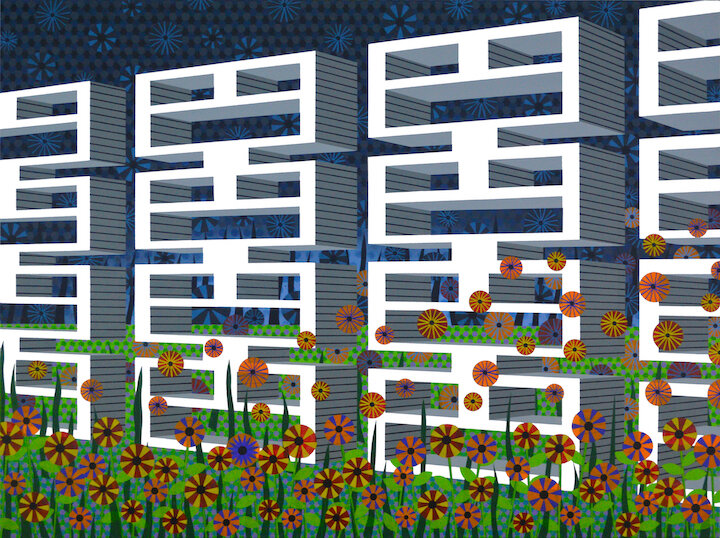
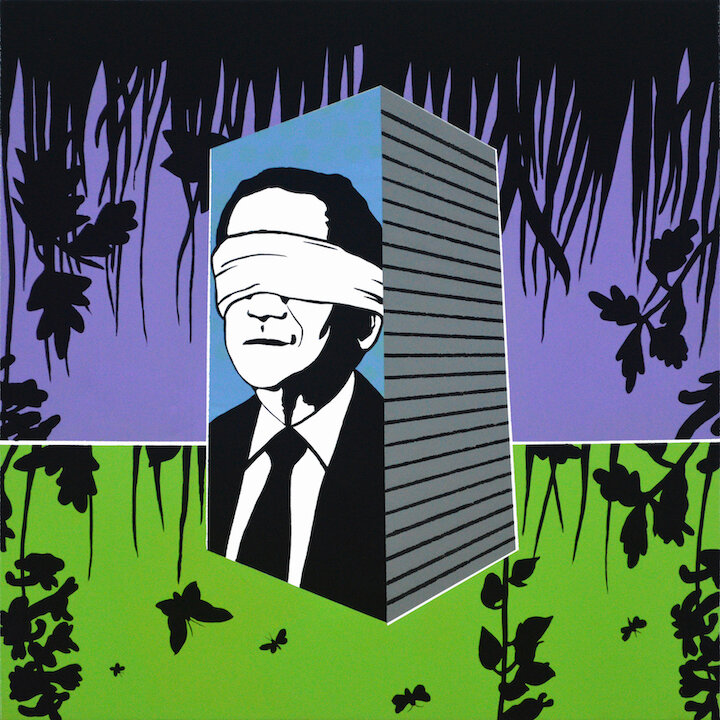
AAS: I believe you are originally from New York State? How did you end up in Little Rock?
CHJ: Let’s just say that a questing spirit and an urge to depart NYC for a while brought me here. I never dreamed it would be a permanent move, but here I am today, over 30 years later. Looking back, I’m happy to say that Arkansas has been very good to me. I’ve been able to sustain an art presence through the years, while working various creative projects to stay afloat. When I connect the dots, it’s fascinating to realize how disparate events influence each other. For instance, just before I moved to Arkansas I was working as a scenic painter in a shop in Jersey City, we did Shakespeare In The Park in Central Park, projects for the then newly minted Nickelodeon, MTV, among others. That experience led to scenic work here with Bylites, Inc. shortly after arriving in Little Rock. A chance meeting through Bylites led to an introduction with the historic preservationist, Becky Witsell. I went on to work with Becky for several years, during which time I learned decorative stenciling techniques. Over time, those techniques began making their way into my art. I often wonder if Becky would be appalled at what I’ve done with her training. It’s a far cry from historic preservation.
AAS: What did you do in New York City and how did that shape the art you are doing now?
CHJ: I’ve been an artist since childhood but switched from an art major to earn a bachelor’s in psychology. I was almost committed to a master’s program but decided to work in a mental health facility first. A couple of years of that convinced me I wasn’t cut out for clinical work. So, in fairly dramatic fashion, I upped sticks for NYC. That was 1982. Once there, I worked in a restaurant in Manhattan, shoulder to shoulder with other artists, actors, and musicians. I immersed myself in the 1980s downtown art scene. I was lucky in that I worked in SOHO, right on West Broadway, so I had a first-hand view of both Leo Castelli and Mary Boone galleries, when they were both still downtown. But my heart was with the burgeoning arts mecca of the East Village. It was a phenomenal time. Art, music, and performance were everywhere – tn the streets – in lofts – in hole-in-the-wall galleries butted up against big new names like Patti Astor’s Fun Gallery. I had my share of shows at funky spaces like Beaulahland and Limbo Lounge, as well as the 9th Precinct Gallery and Emerging Collector Gallery, all of them deep in alphabet city. When the stock market crashed in 1987, all of the collectors from the financial district fled the art market and the East Village scene collapsed almost overnight. It was such a shame.
My canvases were large and expressionist, colorful, and to my mind always reaching forward from the last one. They bear no resemblance to the work I’m doing now. But they are still very important to me. One thing I have brought forward to this day is a commitment to push myself relentlessly wherever inspiration leads. My apologies if this sounds a bit canned, but I could write a book, there was so much going on. Everything that happened then is still vitally important to me.
AAS: Do your paintings start as sketches then become paintings? They are so wonderfully graphic and almost analytical in generating perspective.
Insurrection, 48” x 36”, acrylic and spray paint on canvas
CHJ: I’ve worked from sketches quite a bit. Some of them are barely scribbles, and others have been full blown paintings on paper, developed further on canvas. Ideas can be so fleeting. Getting an idea down, however simple, really helps. On the other hand, I sometimes block out areas on a canvas with no preliminaries, and only a vague notion of where it’s going to go. For example, with Insurrection, I knew I wanted a “trinity” of three buildings, but the figures came to me later along the way. It was all additive process. To me, the three business people represent shadowy patron saints of Wall Street. Their world is being infiltrated by the natural elements - insects and flowers. Thus, the title. But interpretation is for the viewer. I love hearing what people have to tell me about a work.
One thing that keeps these hard-edge pieces challenging is the not quite knowing where things are going along the way. The decision making can be agonizing. I’ve gone weeks not touching a canvas, mid-painting, brooding over the next move. Sometimes I’ll start a second or even third concurrent piece. The juggling gives things energy and moves things forward.
AAS: A few years ago, you started a terrific series call Manscapes. Manscape 22 is a striking image. How and why did that series start?
Manscape 22, 48” x 36”, acrylic on canvas
CHJ: I’m so glad you asked about Manscape 22 ! It’s one of my favorites. For me it has a clarity of not committing to any fixed idea. The businessman is there, of course, but he’s also not there. And where is he, exactly? There’s a sort of cosmic ennui and emptiness involved that I’ve felt very acutely myself. Maybe it’s a self-portrait. Or a comment on western cultural hollowness. He’s drifting and utterly detached.
I started the Manscape series in 2011 as a rebellion against my own creative processes at the time. I was at a crossroads, one of many convulsive artistic episodes I’ve had over the years. When I started the Manscapes, I didn’t know it was a series! But as it progressed, I went after it with a vengeance. Corporate personhood, capitalist breakdown, empty materialist strife, lock-step commercial ossification. It’s an airing of grievances, I guess, while trying to keep it a bit humorous, a bit cartoony. Why bludgeon viewers. The last thing I want is to depress people. Yet, I feel compelled to plow into these themes. My hope is to entertain and amuse while still expressing something of the human condition. As I’ve said elsewhere, the process is in many ways an emotional safety valve. And much of this was before Trump entered the picture!
AAS: A few years ago, you had a show at Matt McLeod Fine Arts Gallery. What was it like to prepare for that show?
Manscape 4, 48” x 36”, acrylic on canvas
CHJ: Utopia/Dystopia, from 2018, was comprised of 30 paintings. It was a pretty exhaustive survey of my work of the previous eight years. Getting the work from studio to gallery walls was quite a chore, but between Matt and I we managed it without incident. I carefully went over each piece and Matt decided where it would hang. His space was huge, but he clearly had a good idea how it would flow.
The theme of the show was pretty broad. The title wasn’t meant to nail everything down. So much of what we call civilization, as exemplified by Athenian Greece, has been built on foundations of the suffering of others. I wanted to reach for that contradiction. Manscape 4 is pretty much an oblique illustration of what the show represented.
AAS: Right before Covid hit, you had a terrific show at the Gallery at Library Square titled Back To The Garden. You have continued that theme with a spectacular work Things You Might Find There. All of these works are so energized.
Things You Might Find There, 36” x 48”, acrylic on canvas
CHJ: The show in the wonderful Concordia space was a peak experience for me. Colin Thompson saw the show at Matt McLeod’s and offered me what turned out to be Back To The Garden. In my mind I saw it as a logical step from the show at Matt’s. Where Utopia/Dystopia wrestled with the present by way of the past, I wanted this show to express hope for the future, in spite of how we got ourselves to this point.
Things You Might Find There actually came about from two of my paintings that were leaning on each other in the studio. I took some photographs of the coincidental juxtaposition and liked what I was seeing. I tried for a hallucinatory, immersive effect. I was reading Michael Pollan’s book, How To Change Your Mind, and many of the new paintings were reflecting my interest in psychedelics and mental health. I created new stencils to accommodate the outsized graphics on the left side of the painting. I used stencil brushes, hand-cut as well as machine cut stencils, and applied thin washes to separate layers, sometimes scraping paint off the surface with a squeegee.
I was given the opportunity to write an ambient electronic soundtrack for the show, which became a 45-minute piece on a continuous loop. The sounds wafted out of the central vault in the center of the room. The culminating painting, Communion, hung by itself in the vault. I used the word communion in a broad sense of bringing people together in reunification with the natural world, back to the garden. You get a little sense of the show from the short video my wife took (below).
AAS: So, as a musician and composer, how has music influenced your work?
CHJ: Music and art have guided my life in tandem. I am a huge fan of all kinds of music. My interest in music has gone from rock and pop to ambient sound and structured noise, field recordings, mystique concrete, all of which I’ve attempted to compose and record at one time or another as a sound artist. I’ve had a few bands, all of which found appreciation more in gallery spaces than bars. We had the plug pulled more than once on some of the more adventurous jams by angry club managers. Cardboard, Behaviorists, Surface Noise, and The Too Much, were some of the band names. I have reams of solo material. I’ve self-produced two CDs, and I hope to produce a vinyl release at some point. But public performance never came easy for me. The cloistered practice of painting is more my speed, but always accompanied by music. Arvo Pärt, Brian Eno, Ravel, Alice Coltrane, Pauline Oliveros – so much brilliant music to set the tone for hours of sheer painterly concentration. The music is a necessary partner in the artistic process.
AAS: You have been in the Delta Exhibition many times, most recently in the 2019 Delta with Loitering. Would you talk about that piece and your experiences at the Delta?
Loitering, 48” x 36”, acrylic on canvas
CHJ: It was fun to get Loitering into the 60th Delta. It’s a piece about reality and simulacra. Modern western culture as simulacra, in Baudrillard’s sense of the word. Culture as simulation. Everything mediated. Staring at cell phones and seeing information, second and third hand, manipulated. Propaganda. Disinformation.
Looking up only when the outside world distracts. Malvinas Richards was way ahead of the game with her song, Little Boxes, back in 1962! Loitering is about me as much as anyone else. After the Delta, the piece was also chosen for last year’s Fort Smith RAM invitational, which was hurriedly switched to a virtual exhibit due to Covid-19. The show ran through the beginning of 2021, and that is the most recent contact my work has had with the outside world. With the spread of the Delta variant, I am in no hurry to rush new work out there. I’m using the time to develop new ideas and think about what art means in a world full of chaos.
AAS: One of my favorite pieces of yours is Fossils Of Our Time. What do these men represent to you?
CHJ: These men represent everything politically and economically wrong in our world. They are the old white guard of government and business. Their eyes are open because they’re still here running the show. They are decapitated and don’t know their time has passed. Their hearts are missing. The piece uses spray paint and pencil as well as stencils and free-hand painting. I’m moving towards mixing up the media more. For the title I borrowed the lyrics from Jefferson Airplane’s great song, Crown Of Creation, “in a place among the fossils of our time.” I cling to the hope that was tattooed onto my brain back when that album came out in 1968. I always reach for the hope and joy of that era when things seem darkest. If my work brings some of that energy to the viewer, then I’m a happy man.
Fossils Of Our Time, 30” x 40”, acrylic and spray paint on canvas
AAS: You have recently been working on a Game Theory series. Would you talk about those pieces and what inspired you to create that form?
Game Theory 2, 24” x 24”, acrylic on canvas
CHJ: The Game Theory pieces are a new development, and this interview is the first time one has been shown in a public forum. Privately, they’ve received mixed reviews from my friends. I always encourage critique and urge people to tell me exactly what they think. Positive responses are great, but negative reactions can be the most fantastic things. None of it is wasted.
The story is that I was resorting to playing simple free games on my phone during early Covid lockdown, and one of the games was called “Block Puzzle.” I played it for a few days when suddenly I thought, “that’s a beautiful image!” I was looking at a half-played game. The colors and shapes were so simple as to be elegant. I decided it would make a great painting. The image was pleasing to the eye, it was appropriated from a mindless app, and I was communicating with my phone as a collaborator. This communication is where game theory came into it. Game theory is tool used in social sciences and economics. It examines the dynamics between two or more participants in a milieu of shifting and unpredictable outcomes. The series is ongoing. I posit my phone as “player 2.” The block game feeds me information and choices, from which I add or subtract variables, considering color, composition, and shape. The game can thwart me, and I lose the image. My phone is a co-author of the paintings. It’s all in fun, and it’s evolving. The process allows me to blow off steam, producing quick(er) finished pieces while constructing the more lengthy productions.
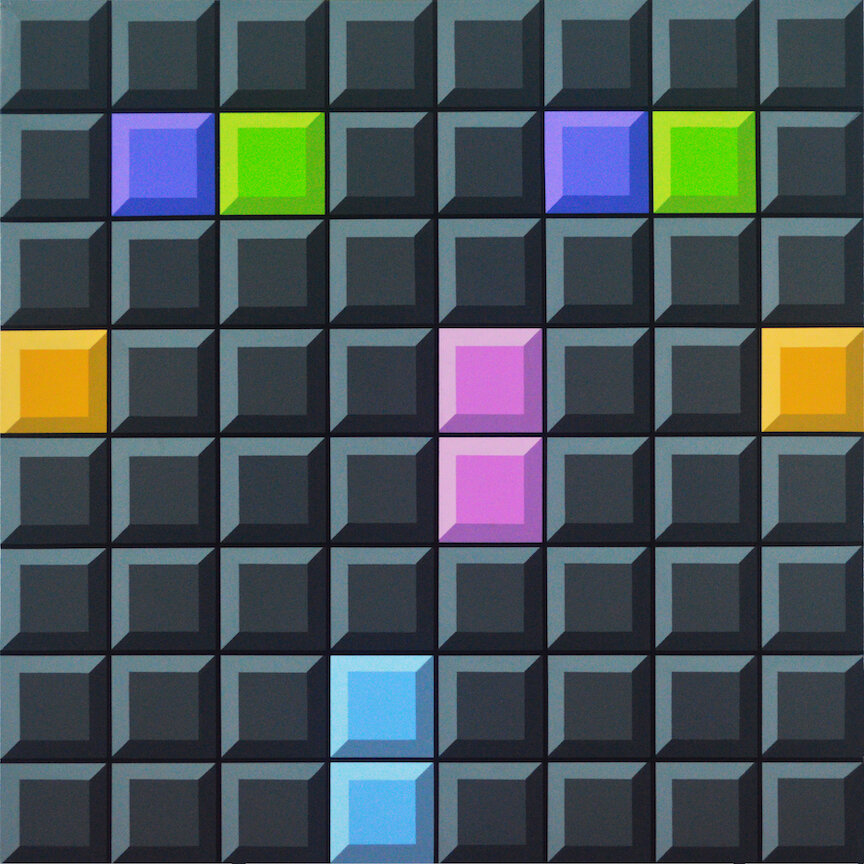
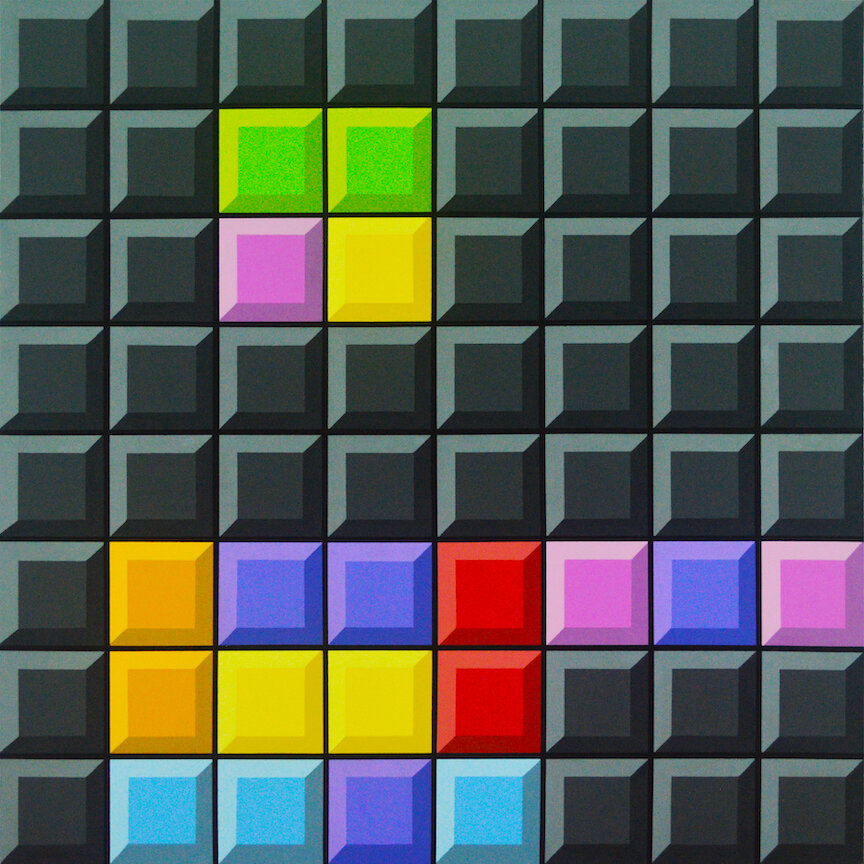
AAS: Charlie, is there anything else you’d like to mention in closing?
CHJ: Yes. First, I’d like to thank my wife Lisa Claas-James for allowing me to live pretty much in the studio, and for her thoughtful critique. I’d also like to thank Anne Holcombe and the Quapaw Quarter United Methodist Church for allowing Lisa and I to occupy such a fine studio, where I’ve enjoyed the best artistic time of my life. Thanks also to Mac and Ashley Murphy for hosting a retrospective of my ‘80s and ‘90s work and my first solo show of the Manscapes in 2016. M2 Gallery has been very supportive of my work over the years. Also, a big shout-out to Matt McLeod, and his much-missed gallery for my Utopia/Dystopia exhibit. Many thanks to Colin Thompson, curator at Galleries at Library Square, for my Back To The Garden show. And, of course, thank you, Philip, for having me on your awesome blog!
Stay safe everyone.
